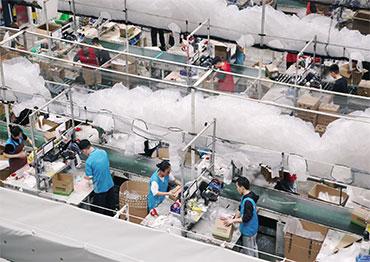In his resignation letter, Daniel Zhang said the spinoff of Alibaba Cloud had reached a crucial stage, which required his undivided attention.
This unit is regarded as having high potential at a time when the cloud computing market is rising, as well as enormous development in big data and artificial intelligence.
Data from the Forward Industry Research Institute shows that in 2020 and 2021, the scale of the domestic cloud computing market increased by 56.7 percent and 48.4 percent respectively, totaling 310.2 billion yuan (US$43.22b) in 2021.
In Alibaba’s financial year of 2023 up to March 31, Alibaba Cloud’s revenue rose to 77.2 billion yuan (US$10.76b), according to Alibaba’s financial report released on May 18, which accounted for 9 percent of the Group’s total income. It posted 1.42 billion yuan (US$197.8m) in adjusted EBITA (earnings before interest, taxes, and amortization, a measure of company profitability), a year-on-year growth of 24 percent, having only been in the black for two years since its establishment in 2008.
The market share of Alibaba Cloud has expanded for six years, ranking third in the global IaaS (infrastructure as a service) market in 2021, behind Amazon Web Services (AWS) and Microsoft Azure, according to data released by research firm Gartner in 2022.
By March 31, the cloud unit had provided services to over four million customers worldwide, including 80 percent of Chinese tech companies.
After Taobao and Tmall, which contribute 70 percent of Alibaba’s income, the cloud unit is expected be the second-biggest source of income, although it faces challenges both in expanding global market share and fierce competition at home.
This is likely why Daniel Zhang is prioritizing it, observers said.
A report published by market research platform IDC in April shows that Alibaba Cloud remains the top IaaS+PaaS (platform as a service) provider in China, followed by Huawei Cloud and China Telecom’s cloud unit CTYun, accounting for 31.9 percent of the domestic market. But its market share dropped from 36.7 percent in the first half of 2022 and 42.7 percent in the second half of 2018. Huawei Cloud and CTYun both increased their market share in the latter half of 2022.
In recent months, domestic cloud service providers including Alibaba Cloud and Tencent Cloud have lowered prices, starting a new price war.
Separating the cloud unit from Alibaba Group is seen as a step to allow it to complete an IPO and attract more outside investors to help it compete with other domestic cloud service providers.
On May 18, Zhang announced that Alibaba Cloud would completely spin off from Alibaba Group and is expected to complete its IPO in the next 12 months. The cloud unit will accept strategic investors from abroad.
Cainiao, the logistics unit, and the grocery brand Freshippo with its Hema brick-and-mortar stores, have also started the listing process, while Alibaba International Digital Commerce Group, which includes platforms like AliExpress and Southeast Asia-focused Lazada, has brought in external financing, and the six major business groups have officially established their boards of directors, according to Alibaba’s 2023 financial report released in July.
The spinoff and separate listing will bring brand new challenges for both Alibaba Group and the six business groups, according to analysts.
The “1+6+N” structure means the holding group will manage the subsidiary groups: It needs to both think as a whole and coordinate sections and assist in innovation, Cui Lili said.
The purpose of the spinoff is to let these business groups be responsible for their own profits and losses, pointed out Wong Yi, a senior researcher with DE Thinktank. He believes that the spinoff will strengthen each one and test their market capabilities. ��
But ensuring synergy and avoiding internal competition while following a consistent strategy will be an issue, director of Bestar Consultant Xing Xing noted. With separate listings, the parent company will focus on management and improving its subsidiaries’ profitability. But after the advantageous assets are separated, maintaining the parent company’s investment value will be a challenge, Xing said.
On August 10, Alibaba announced its financial results for the second quarter of the year, the first following its organizational restructure. The results show year-on-year growth of 14 percent in revenue while income from operations increased by 70 percent year-on-year. Among the main spin-offs, the revenue of Taobao & Tmall Group grew by 12 percent year-on-year while its local service, logistics and cloud service spin-offs respectively grew by 30 percent, 34 percent and 4 percent. Its China commerce retail business increased by 13 percent over the same period of 2022. The result was better than market expectations, and analysts believe it shows tacit market approval for Alibaba’s reshuffle.

 Old Version
Old Version



